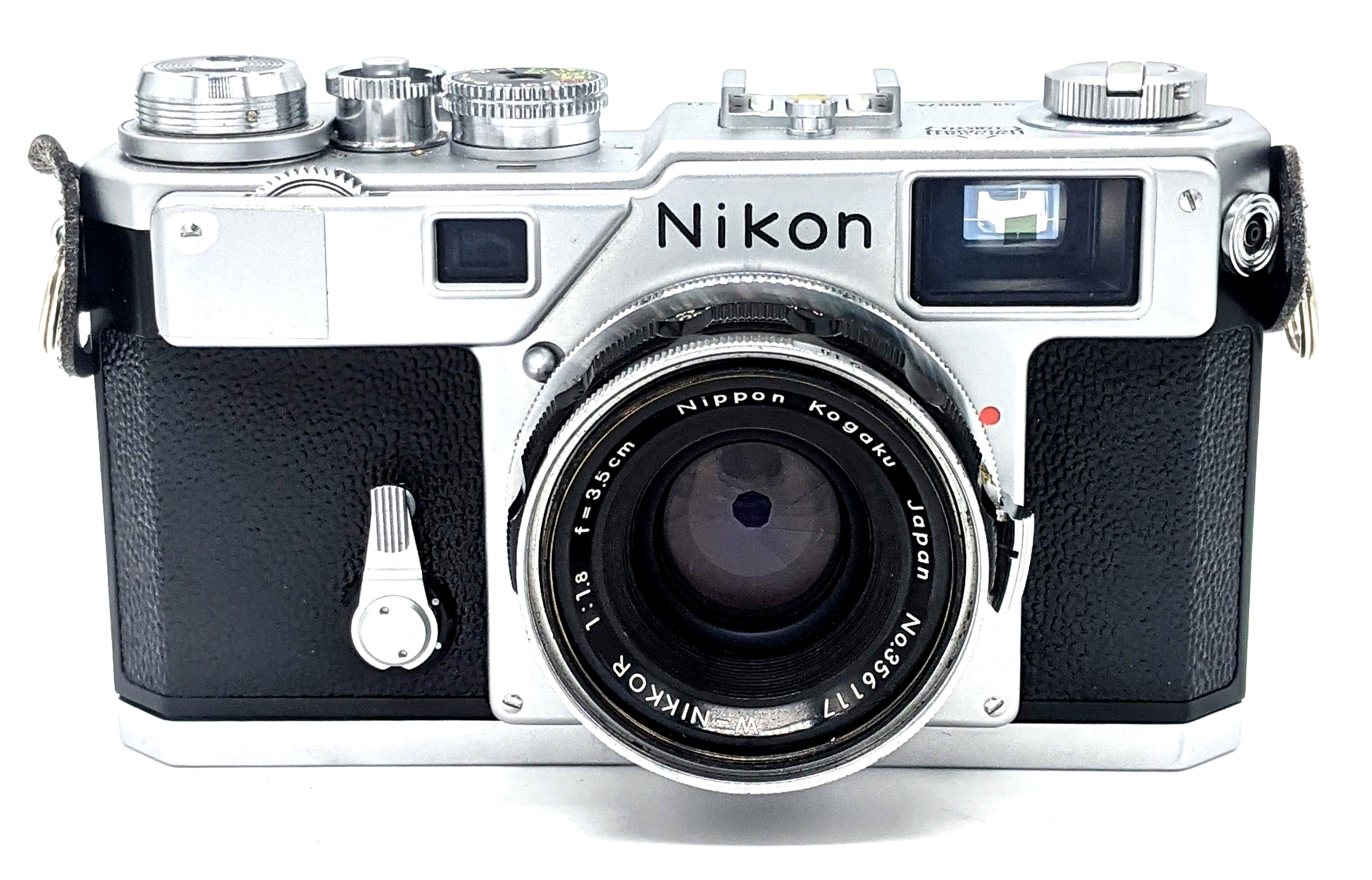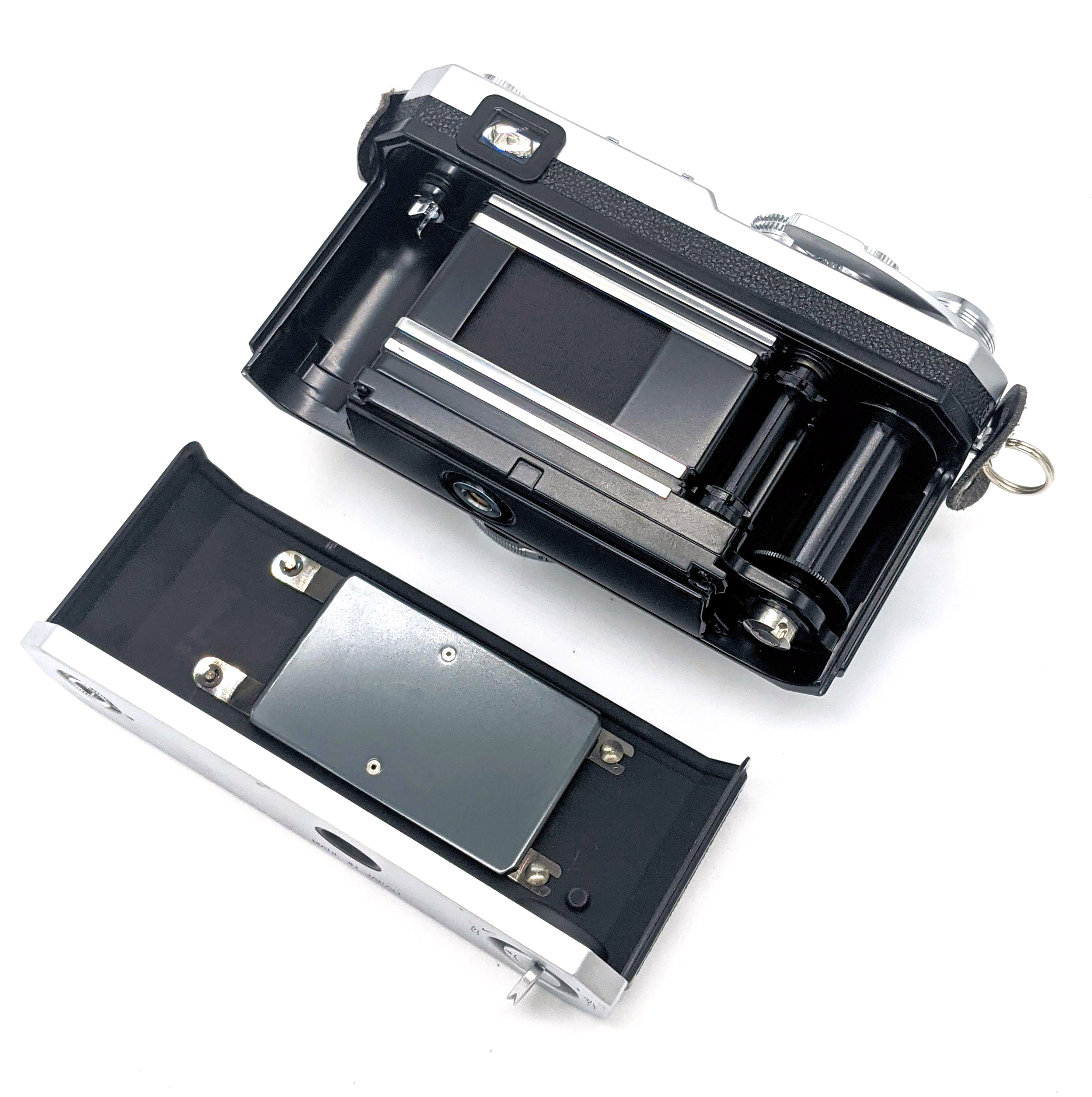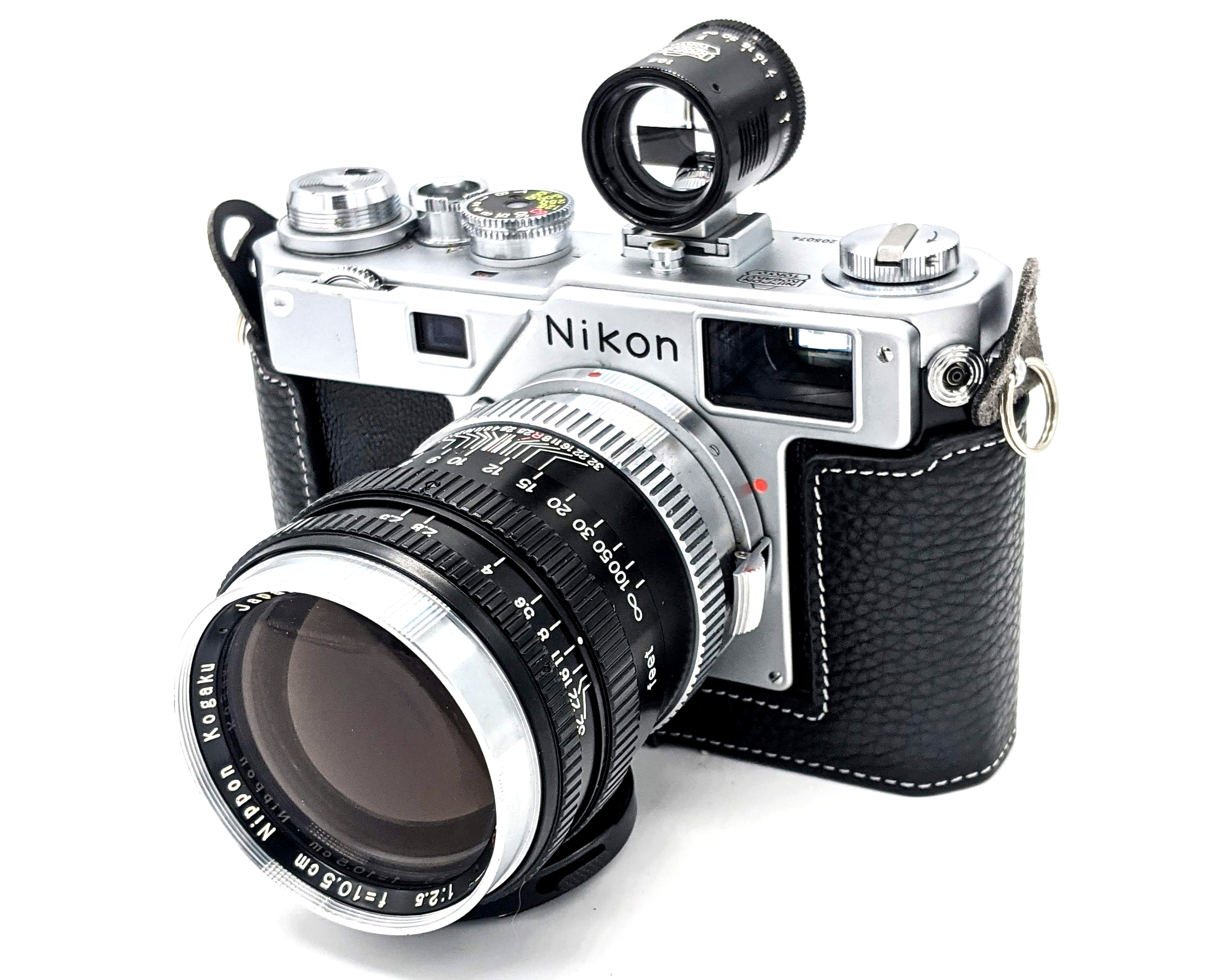
In a project launched in 1998, Nikon spent an extraordinary amount of effort recreating its 1958-64 S3 rangefinder camera. If you have not already, be sure to read Nikon’s official account of this project. In short, a leading Nikon employee had an idea to recreate the company’s S3 rangefinder lens with a copy of its mid-1960s “Olympic” version of its 50mm f/1.4 S-mount lens. As part of the research phase, Nikon engineers reportedly had to go out and purchase a few original S3s from local camera stores. In 2000, Nikon launched its new S3 in the Japanese domestic market, including a recreation of the original packaging, the body, the lens, the lens cap, and the lens hood. In 2002, Nikon produced an additional 2,000 “black paint” copies. Not quite finished with the trip down memory lane, in 2005, Nikon produced 2,500 black-paint replicas of its classic SP rangefinder paired this time with a re-pop of its world-famous 35mm f/1.8 W-Nikkor.
Although Nikon had to modify just a few minor parts from the original S3, there is no doubt that that the year 2000 S3, like its late 1950s predecessor, exhibits outstanding craftsmanship and attention to detail. But, other than as a conversation piece or a shelf queen, is the 2000 S3 actually a good real-world shooter in the 21st century? I am not quite sure. Let’s take a look.
The Viewfinder & Focusing Accuracy
Although bright and life-sized, the S3’s viewfinder is its own greatest enemy. In an era where most major manufacturers used projected (or reflected) framelines, the S3’s 35/50/105 thick, cluttered, non-parallax corrected framelines are etched into the piece of glass closest to your eye. The decision to go with etched framelines is puzzling, as Nikon’s S2 and SP rangefinders both used projected framelines.
It gets a little worse. The 35mm frameline cannot be really seen if glasses are worn, and barely can be seen without them. Even if specific diopters did exist at some point for the S3, you will likely have a hard time finding one today. The S3 really appears to be optimized for non-glasses-wearing, right-eyed shooters keeping both eyes open. If you can accomplish this, the viewfinder is actually pretty great. Additionally, if you are unfamiliar with Nikon rangefinders, the rangefinder patch is not the nice, easy-to-see rectangle used by Leicas. It is a fuzzy deal that can be difficult to see without some practice. At the same time, the 50mm and 105mm framelines are easy to see, yet they are almost on top of each other.
The combination of the S3’s incredibly long effective rangefinder baselength plus the relatively long focus-throws of S-mount lenses can make for accurate focusing at the widest apertures. However, because there is no viewfinder parallax correction, framing will be off a closer distances with a 50mm and are incredibly off with the 105mm. If you are going to use the 105mm at closer distances, you almost have to invest in the Nikon 105mm external viewfinder, which can be parallax-corrected.

Operation
Despite the shortcomings of its viewfinder, the S3’s design is well thought out, intuitive, and with high quality parts everywhere. Much of the original S3 made its way into the 1959 Nikon F SLR. Here are a few highlights.
Focusing: As with Contax, Nikon rangefinder lenses come in two varieties: external mount and internal mount. External-mount lenses are conventional with their helicoids in the barrel. They latch onto the outside of the S3’s lens mount. Internal-mount lenses use the camera body itself for the helicoids. Focusing can be accomplished in two ways: either turn the lens barrel to line up the rangefinder patch or use the finger wheel on the body. The minimum focusing capability of the body is only 0.9m. This is another bummer as the S3’s long effective rangefinder baselength is capable of accurately focusing fast lenses at much closer distances than that. Finally, because most S-mount rangefinder lenses want to turn when you want to change the aperture, you must usually hold the focus in place to do this.
Shutter: The rubberized-silk shutter is smooth as, well, silk. It creates little noise and little vibration. It is not as quiet as Leica, but it is pretty close. The top shutter speed is 1/1000, as good as it got during the 1950s.
Manual Exposure: Because the S3 comes from a time before camera electronics, there are plenty of dials and switches. There is a sync port for a bulb flash is right in front of the hot shoe. The film counter window is above the advance lever, which also contains a reminder for how many exposures are on the film you are using. There is a shutter lock around the shutter lock. There is a film speed reminder dial on the bottom of the camera. There is a self-timer switch on the front.
Flash: The S3 was introduced at a time when electronic flashes were just becoming widely available. At the time, it was assumed that you would be using some kind of bulb flash system, which of course has not been used now for at least 50 years. However, the S3 does have a X-sync port on the side which will work with any modern flash. The flash modes must be manually scrolled through by lifting up and turning the ring around the shutter speed dial. The X-sync speed is 1/60 and below, slightly better than a Leica M’s 1/50.
Film Loading: For those unfamiliar with Nikon rangefinders in general, the S3 requires the removal of the camera back to access the film loading mechanism. However, unlike Leica Ms, one can simply pull the film across the plane and into the take up spool without an unnecessary headache.
Accessories: During its production run, the S3 had a few dedicated accessories, most of which are not very common today. These accessories will still work with the 2000 re-issue. These includes a case (the new case has a longer nose for the new 50mm lens), a shoe-mount coupled selenium light meter (most surviving examples are now dead), and the BC-4 bulb-flash unit. The holy grail accessory for the S3 is its S36 motor drive. The S36 replaced the back of the camera with bottom-mounted motor drive powered by an external battery pack. These units, when working, sell for multiple thousands of dollars. Too bad Nikon did not make a modern version of these when it had the chance.

Versus the Voigtlander Bessa R2S
An obvious alternative to an S3 (or SP) would be the short-lived 2002-05 Voigtlander Bessa R2S. Based upon the chassis of the Leica-mount Bessa R2, the Cosina-produced R2C (Contax mount) and R2S (Nikon S mount) were the first new cameras in those mounts made in nearly 40 years. Along with the camera bodies, Cosina also re-popped some of its existing Leica-mount lens designs for the systems. While not selling particularly well at the time, people seem to be only now appreciating them. Consequently, used copies of the R2C and the R2S have exploded in value, selling sometimes for double or triple than what they cost brand new.
Here is a comparison of the specs between the S3 and the R2S.
| Nikon S3 | Bessa R2S | |
| Years Produced | 1958-64; 2000-02 | 2002-05 |
| VF Coverage / Magnification | 100% / 1.00x | 87% / 0.70x |
| Shutter Speed Range | B, 1 sec – 1/1000 | B, 1 sec – 1/2000 |
| Minimum Focus | 0.9m | 0.9m |
| Shutter Design | Rubberized-Silk Horizontal Focal Plane | Copal Metal Vertical Focal Plane |
| Weight | 590g | 520g |
| Metering | None | Center-Weighted |
| Framelines | Etched, Non-Parallax-Corrected 35/50/105 | Projected Parallax-Corrected 35/50/85 |
| Optional Winder | S36 Motor Drive | Trigger Winder |
| Effective RF Baselength | 60mm | 25.53mm |
| Batteries | None | 2 x SR44 |
| Flash X-Sync | PC; 1/60 | Hot Shoe; 1/125 |
Of course, the largest advantages that the R2S have over the S3 is the existence of a built-in light meter, a faster top shutter speed, and parallax-corrected framelines. However, while metering and fast shutter speeds are always a plus, the S3’s longer rangefinder baselength can effectively focus S-mount lenses far more accurately than the R2S. Also, in my opinion, Cosina may have made a miscalculation by not making the R2S’ framelines 35/50/105, instead of 85. While Nikon’s S-mount 85mm f/2 is a fine lens, and with the 85mm f/1.5 currently an unobtanium collectors’ model, being able to accommodate natively the superb and common 105mm f/2.5 would have been killer.
Nikon Rangefinder Lenses
The number one reason why you would want to use a Nikon rangefinder camera is to shoot with the world of S-mount lenses. Although all of the original 1940s-60s lenses for the system have been long surpassed in objective optical performance, and with certain of the rarer and faster lenses like the 50mm f/1.1 and 85mm f/1.5 remaining hopelessly expensive collectors’ items, the S-mount lenses still are capable of producing fantastic images. The main drawback of these older lenses is not so much their optical design but their primitive lens coatings, which result in sometimes strange color rendition, flaring, and loss of contrast at wider apertures.
As an initial matter, the ideal modern platform for S-mount lenses may not be a Nikon rangefinder camera at all, but a Leica M-mount body. With the various iterations of the rangefinder-coupled Amedeo S-mount to M adapter, it is far easier and more economical to mount these lenses to a metered Leica M body, a Zeiss Ikon ZM, a Minolta CLE, or an R2-R4 Voigtlander Bessa. With the CLE and M7, you can even get aperture-priority autoexposure with these lenses.
Unfortunately, while the vast majority of S-mount lenses can be used on a Leica M platform with the adapter, certain lenses (i.e., arguably, the most desirable) cannot as their design interferes with the Leica rangefinder cam. The 21mm f/4.5 Contax Biogon, the 21mm f/4 Nikkor-O , the 25mm f/4 W-Nikkor, the 35mm f/1.8 W-Nikkor, and the 50mm f/1.1 Nikkor-N cannot work with any adapter currently being made. What a bummer. Furthermore, unless you have an M-mount camera that can manually select and lock framelines, the current M adapters will only bring up the 50mm framelines, making it cumbersome to use 28/35/85/105 lenses. Of course, apart from the 21mm Biogon, you can try to find the rare M39 versions of the aforementioned lenses somewhere, but these tend to be very expensive and are becoming more so. As perhaps the ultimate camera body alternative, you can go for the Bessa R2S, which can use all S-mount lenses without restriction.
If looking for lenses for the S3, an ideal set would match its 35/50/105 framelines.
35mm: There are plenty of OEM and aftermarket options in the 35mm focal length for Nikon rangefinders. Nikon produced three different 35s: a 35mm f/3.5, a 35mm f/2.5, and a 35mm f/1.8. The f/3.5 is an older design and is not as good as the others. Between the 35mm f/1.8 and f/2.5, the slower f/2.5 is arguably a better “all-around” lens, with good distortion control, no real focus shift, useable at all apertures, and is approximately comparable with the 1950s Leica 35mm f/2.8 Summaron. What the fast f/1.8 does well is control distortion and is very sharp in the center. It has typical light fall-off at wider apertures and its single coating shows its age, especially in color shooting. Finally, the 1.8 has some pronounced focus shift as the lens is stopped down.
There were several third-party companies like Komura that produced S-mount lenses in the 35mm focal length Although Contax and Nikon rangefinders have a small registration difference, the lenses at 35mm and wider can generally be interchanged with each other. This means that any of the numerous versions of the pre-war and post-war 35mm f/2.8 Contax Biogons can be used. However, I am not sure whether the Biogon is a better lens than the 35mm f/2.5 W-Nikkor. Finally, Voigtlander produced a version of its Leica-mount 35mm f/2.5 Color Skopar, which is an excellent lens and probably the best overall S-mount 35mm.
50mm: The choices in 50mm include a few OEM lenses and some modern lenses Voigtlander introduced in connection with the R2S. Nikon’s 50mm f/1.4 came in three varieties: a 1950s Sonnar-derivative, a 1960s Double-Gauss version, and the 2000 Double-Gauss re-issue. The 1950s f/1.4 is ubiquitous and very affordable. However, it also has primitive lens coatings and noticeable focus shift. The 1960s “Olympic” f/1.4 is a rare bird, but its Double Gauss design makes it more suitable for general applications and will work well at all apertures. The 2000 re-issue f/1.4 is more or less the same basic optical design as the 1960s version but with modern lens coatings. It is a really good lens, pretty much maxing out at f/8 or f/11 like most lenses of its class, most likely better in objective performance than any “classic” 1950s or 1960s 35mm rangefinder lens from any manufacturer, but is not as good as a modern Summicron. Voigtlander produced three S-mount lenses in the 50mm focal length: a 50mm f/1.5 Nokton, 50mm f/2.5 Skopar, and 50mm f/3.5 Heliar. These are all excellent lenses.
105mm: The 105mm f/2.5 Nikkor-P was one of Nikon’s best rangefinder lens designs, more or less replacing the earlier 85mm f/2. Produced in relatively large quantities and eminently affordable, the 105mm was the only Nikon rangefinder lens to be reworked with only minor tweaks as a regular (non-mirror-lockup) F-mount SLR lens, in use until the early 1970s. Using the Sonnar template, the 105mm is a fantastic portrait and landscape lens. The F-mount version is still regarded as one of Nikon’s best portrait lenses ever for its flattering rendering. It is best used at about f/2.8-4 for close up subjects and f/8-11 for longer distances. Komura also made several 105s in S-mount, a 105mm f/2.8 and a 105mm f/2. Both of these Komura lenses are quite rare today and it is not clear if they are any better than the Nikkor-P.

Conclusions
If I had been Nikon in the late 1990s, instead of putting forth the extraordinary effort to create a breathtaking copy of the S3, a camera that during its own time was neither revolutionary nor had any unique capabilities, I would have designed and produced a brand-new S-mount camera from the ground up. A “Nikon S5,” if you will. Use the FM3a’s 1/4000 top-speed hybrid mechanical/automatic shutter, metering with aperture-priority autoexposure, swing-back film loading, and selectable framelines with maybe varying degrees of viewfinder magnification. This was not theoretically unachievable as both Konica and Cosina built ground-up, innovative Leica-mount film cameras during this same era. Would an “S5” have been a more expensive and less profitable endeavor than reverse engineering and then hand-building the S3 and SP re-issues? I guess we will never know. Also, as long as they were re-making these lenses in S-mount, Nikon should have considered making Leica-mount versions of the new 50mm f/1.4 and 35mm f/1.8 W-Nikkor.
To me, unless you are just in love with the concept, the S3 does not present a compelling case as a regular shooter. Apart from the non-metered operation, the cluttered, non-parallax-corrected viewfinder make taking photos kind of chore. To me, the R2S seems like an overall better choice as an actual shooter. In the end, although Nikon’s 2000 S3 is indisputably a masterpiece of design and engineering, and remains relatively cheap in the market today despite its uniqueness and incredible build quality, it is not for me a go-to platform for rangefinder photography.
[…] line in 1984 – 38 years ago. That’s only a few years less than the gap between the original Nikon S3, released in 1958, and the Millennium model of 2000. That camera was such a sideways step from the […]
[…] in 1984 – 38 years in the past. That’s just a few years lower than the hole between the unique Nikon S3, launched in 1958, and the Millennium model of 2000. That digicam was such a sideways step from the […]